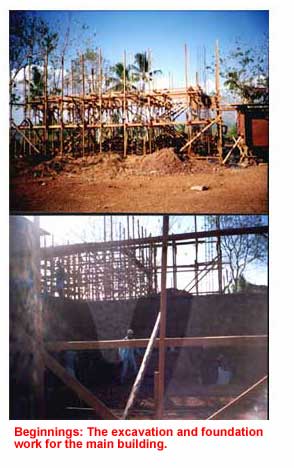


Construction started March
1998 and continues to date, an intermittent endeavor during annual
5- or 6-month sabbaticals. The early phase was supervised by my
brother, Rollie - hiring the crew, setting up the on-site hollow-block
production (which turned out inferior grade blocks), excavation
and pouring the foundations for the main building, and starting
the search and contracting for the drilling for a water source,
which we hoped to find within the peak's 2.7 hectares.
Even before construction began, the vision of the one-room school house already went through many revisions, in size and design, in form and function. There were no architectural plans, no engineering consultants, just countless drawings and sketches on bond, pieces torn off cardboard boxes, the back of pin-up girly-calendars, scraps pieces of plywood, or ephemeral etchings on the ground. There was an early attempt to put it all into a composite whole in the computer; but, that failed early on, lacking the immediacy of access and the too many eurekas that necessitated too frequent revisions.
The crew consisted numbered from 6 to 30, depending on the complexity of the phase of the project. The max count of 30 consisted of a foreman, about 13-14 skilled workers, 15-16 helpers; some are farmers-carpenters, in-between harvest, some from the pool of the chronically idle or the intermittently employed. The cost of construction supplies are the same - sometimes, more - as developed countries. What is inexpensive is manpower: at P50/$, the range of daily wage for a foreman is about $7-8/day, the skilled worker, $6-7/day and the helper $4/day.
Except for the electric drill, plane/sander and tile cutter that came much later, everything was done by hand.
